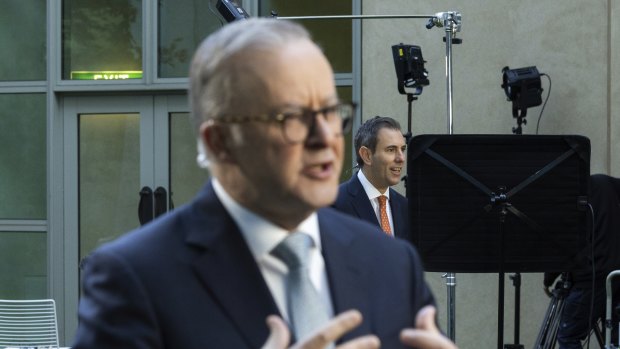This was published 2 years ago
PM talks up low-income stage three tax cuts as Chalmers worries about deficits
By Shane Wright
Prime Minister Anthony Albanese has highlighted the benefits of the planned $254 billion stage three tax cuts for low-income earners while Treasurer Jim Chalmers signalled more tax may be needed to properly repair the federal budget.
As a senior economist called on the government to dramatically expand the tax cuts in a bid to force wholesale change to the tax system, Albanese and Chalmers stuck to a tight script on their attitude toward the reforms, which are due to start in the middle of next year.

Anthony Albanese and Jim Chalmers, explaining Tuesday’s budget, were pressed on the future of the stage three tax cuts.Credit: Alex Ellinghausen
Chalmers this week revealed the cost of the tax cuts in their first four years had grown to $69 billion, in part due to the strength of the jobs market and higher wages for affected workers. In their first year of operation, when the government expects to run a budget deficit of $35.1 billion, they will cost $21.5 billion.
The cuts will deliver their largest benefit to people earning more than $200,000 a year.
But Albanese, during Wednesday’s traditional post-budget media blitz, said while the focus was on high-income earners, many people on modest wages would benefit from the stage three reforms.
“Those measures begin at $45,000. If you’re on $45,000 … you don’t regard yourself as being wealthy,” he told ABC TV.
“We have no plans to change those measures. We haven’t given consideration to that.”
The budget revealed the nation’s tax-to-GDP ratio will reach 23.9 per cent next financial year, the highest rate since 2005-06. That ratio will fall when the tax cuts start in 2024, but, without them, they would reach a record high.
Chalmers noted there were structural pressures on the budget that may require more revenue.
“We’ve got a structural challenge in the budget. We made really good progress on it last night but we’ve got more work to do,” he said.
Most critics of the stage three tax cuts believe they should be abandoned completely or modified to reduce the large benefits that will flow to high-income earners.

Pradeep Philip says the government should consider expanding the stage three tax cuts.Credit: Eamon Gallagher
But Pradeep Philip, Deloitte Access Economics lead partner, said on Wednesday the government should expand them.
He said the tax-free threshold should be increased to $30,000 (from $18,200), a 30 per cent tax rate imposed on income earned between $30,000 and $200,000, and then a 45 per cent rate for all incomes above $200,000.
The change would cost about $175 billion over the next decade.
A person earning $30,000 would enjoy a tax cut of $2200, and, according to Philip, the change would sharply reduce the high effective marginal tax rates that hit low-income earners on every extra dollar they earn.
Philip said the deep cut in personal income tax would force the government to consider other substantial changes to the tax system, such as an increase in the GST, making the system more efficient while reducing current distortions.
“If you drive down income tax it forces wholesale tax reform,” he said.
“We’ve had this tax debate for a long time, and we only deal with it incrementally, so maybe going further on stage three could be a bit of a circuit breaker because it sharply focuses the mind on how do you raise revenue for the rest of the task of the budget.”
Cut through the noise of federal politics with news, views and expert analysis from Jacqueline Maley. Subscribers can sign up to our weekly Inside Politics newsletter here.